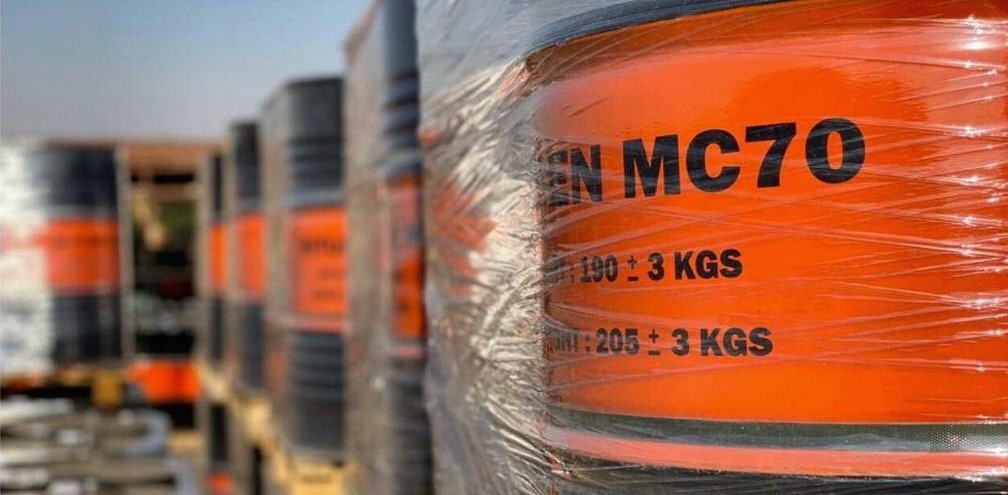
Definition of Cutback Bitumen MC 70
Cutback bitumen MC 70 is a type of bituminous material widely used in road construction and maintenance. The term “cutback” in cutback bitumen refers to the reduction of bitumen’s viscosity, allowing it to be applied as a liquid and then curing or setting as the solvent evaporates. This process makes it possible to use bitumen in various road applications where temperature-controlled applications may not be practical.
Cutback bitumen finds application in various road construction and maintenance tasks, including prime coating, tack coating, surface treatments, dust control, and patching. However, it’s important to note that the use of cutback bitumen has environmental implications due to the volatile solvents it contains, which can contribute to air pollution. As a result, there has been a shift towards using more environmentally friendly alternatives like emulsified asphalt in some regions.
MC 70 cutback bitumen is a bitumen that has been diluted with a solvent to reduce its viscosity and make it easier to handle and apply. The solvent used in MC 70 cutback bitumen is typically a volatile petroleum distillate, such as kerosene or diesel.
MC 70 cutback bitumen is often used for various road construction applications, including prime coating, tack coating, and surface dressing. It is applied by spraying or brushing onto the road surface to improve adhesion between layers of asphalt pavement or between the existing road surface and new asphalt overlays.
As with other cutback bitumen products, it is essential to follow proper safety precautions when handling and applying MC 70 cutback bitumen. The solvents used in the mixture can be flammable and pose health risks if not handled properly. It is important to adhere to local regulations and guidelines to ensure the safe and effective use of MC 70 cutback bitumen in road construction projects.
Application of Cutback MC 70
Cutback Bitumen MC 70 Application is in permeable prime layers and production of adhesive or storage mixtures. Cutback asphalt used in mixing with aggregate usually contains a binding agent to help coat the surface of the aggregate. Also, cutback bitumen is ideal for primary coating and cold application due to its easy application and no need for thinning and heating.
More applications of Cutback Bitumen MC 70 are:
- Prime Coat: MC 70 can be used as a bonding agent, promoting adhesion between the existing road surface and the new asphalt layer, and it helps to prevent moisture infiltration.
- Tack Coat: MC 70 can be used as a tack coat between the layers When constructing multiple layers of asphalt. It ensures a strong bond between the old and new asphalt layers, reducing the likelihood of delamination and improving the overall structural integrity of the road.
- Repair: MC 70 can be used In road maintenance and used for patching and repairing damaged or deteriorated sections of asphalt roads.
- Surface Treatment: MC 70 can be used in surface treatment applications. It is sprayed onto the road surface and then covered with a layer of aggregate or chips.
Healthy and Safety of Bitumen MC 70
Cutback Bitumen MC 70 is a hazardous material and should be handled with care. Some safety tips when using Bitumen MC 70 are:
- Protective Equipment: Always wear appropriate PPE when handling Cutback Bitumen MC 70, including gloves, safety goggles, and protective clothing.
- Ventilation: Ensure that there is adequate ventilation when using Cutback Bitumen MC 70, as the fumes can be hazardous.
- Handling and Transfer: Transport Cutback Bitumen MC 70 in approved containers and vehicles, following all safety regulations.
Packing of Cutback Bitumen MC 70
The Bitumen MC 70 is usually packed in bulk, Steel Drum, and IBC Tank but The packing type depends on the quantity of the product and the specific requirements of the customer.
Specification of Cutback MC 70
| Properties | Min | Max | Test Method |
|---|---|---|---|
| Kinematic viscosity at 60°c ,cST | 70 | 140 | ASTM D2170 |
| Flash point(tag open cup), °C | 38 | --- | ASTM D3143 |
| Residue from distillation to 437°F (225°C) | --- | 20 | ASTM D402 |
| to 500°F (260°C) | 10 | 70 | ASTM D402 |
| to 600°F (316°C) | 65 | 93 | ASTM D402 |
| to 680°F (360°C), per cent volume by difference | 53 | --- | ASTM D402 |
| Viscosity at 140°F (60°C) | 30 | 120 | ASTM D2170 |
| Penetration 77°F (25°C) 100g, 5s mm | 120 | 300 | ASTM D5 |
| Ductility 77°F (25°C) 5cm/min cm | 100 | --- | ASTM D113 |
| Solubility in trichloroethylene % | 99 | --- | ASTM D2042 |
| Water, percent volume | --- | 0.2 | ASTM D95 |

